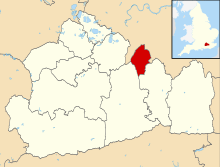Ewell
Ewell (/ˈjuːəl/ (![]()
| Ewell | |
|---|---|
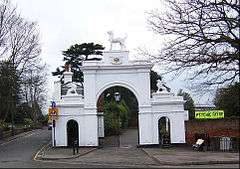 Dog Gate Bourne Hall and Spring Street Ewell | |
Saint Mary the Virgin, parish church | |
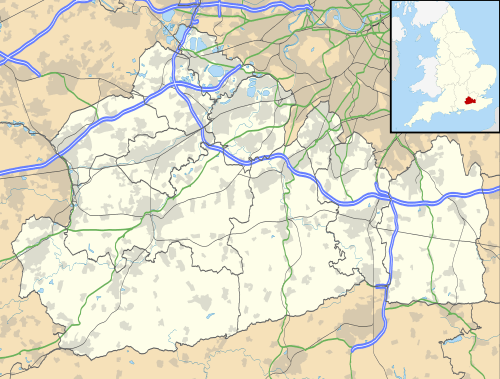 Ewell Location within Surrey | |
| Area | 14.09 km2 (5.44 sq mi) |
| Population | 34,872 (2011 census)[1] |
| • Density | 2,475/km2 (6,410/sq mi) |
| OS grid reference | TQ2263 |
| • London | 12.1 mi (19.5 km) |
| District | |
| Shire county | |
| Region | |
| Country | England |
| Sovereign state | United Kingdom |
| Post town | EPSOM |
| Postcode district | KT17 KT19 |
| Dialling code | 020 |
| Police | Surrey |
| Fire | Surrey |
| Ambulance | South East Coast |
| UK Parliament | |
Ewell was founded as a spring line settlement, where the permeable chalk of the North Downs meets the impermeable London Clay, and the Hogsmill River (a tributary of the River Thames) still rises at a spring close to Bourne Hall in the village centre. Recorded in Domesday Book as Etwelle, the settlement was granted a licence to hold a market in 1618.[3] The opening of railway stations to the east and west of the centre, in 1847 and 1859 respectively, facilitated the creation of extensive residential areas, which are now contiguous with the Greater London suburbs.
History
The name Ewell derives from Old English æwell, which means river source or spring.
Bronze Age remains have been found in Ewell[4][5] and the Romans are likely to have encountered an existing religious site when they first arrived leaving pottery, bones, and a few other remains, which have been taken to the British Museum.[3] Ewell is on a long line of spring line settlements founded along the foot of hills on a geological line between the chalk of the North Downs to the south, and the clay of the London Basin to the north.
The Roman road Stane Street from Chichester deviates from straight slightly at Ewell to pass by the central spring. Its successor, the A24 (London Road) runs from Merton to Ewell along the course of the Roman road, and leaves Ewell also with a by-pass connecting it to Epsom.[n 1]
Ewell lay within the Copthorne hundred.
Ewell appears in Domesday Book of 1086 as Etwelle. It was held by William the Conqueror. Its assets were: 13½ hides; 2 mills worth 10s, 16 ploughs, 14 acres (5.7 ha) of meadow, woodland and herbage worth 111 hogs. It rendered £25 per year to its feudal system overlords; also £1 from the church in Leatherhead, it was held by Osbert de Ow and was attached to his manor.[6] In the 13th century Ewell's current spelling appears, in the Testa de Nevill.[3]
King Henry VIII established here in 1538 Nonsuch Palace on the borders of Cheam, considered one of his greatest building projects. The estate, now Nonsuch Park, a public park, was one of his favourite hunting grounds, although no trace of the palace remains, having been destroyed during the 17th century. In the same park, is Nonsuch Mansion a grade II* listed 18th century house occasionally open to visitors.[7]
In 1618 Henry Lloyd, lord of the manor, was granted licence to hold a market in Ewell.[3] Tunnels dating from the English Civil War exist underneath Ewell but are poorly documented and inaccessible to the public. One such secret passage is reported to emerge under the shop on the corner of West Street and High Street. The market died away in the early 19th century.[3]
Samuel Pepys visited Ewell on numerous occasions in the 17th century and the area is mentioned several times between 1663 and 1665 in his diary, in which he spells it Yowell.[8]
The enclosure (privatisation) of its common fields of 707 acres (286 ha) in the east and its infertile land ('waste') of 495 acres (200 ha) was carried out in 1801.[3] In 1811 a National School was established sponsored by Mr. White and Mr. Brumfield. Thomas Calverley built the large architecturally listed home Ewell Castle in 1814 in an imitation castellated style and gave the school financial benefaction, which became available in 1860.[3][9] In 1879 Ewell Court House, latterly a library was built with a grotto that survives.[10]
In the 1980s, an elderly lifelong resident of Ewell, named Digeance, recalled the pasture land and orchards that stretched north and west right across to Berrylands in the Royal Borough of Kingston upon Thames. This radical transformation is documented in the photography collected in the book Archive Photos – Epsom and Ewell.[11] The suburban residential development across that area is mainly 1930s/40s semi-detached houses, although some Edwardian, Victorian and earlier architecture is still present. The Hogsmill Open Space gives an indication of Ewell's rural pre-war history.
Government and politics
The town lies within the parliamentary constituency of Epsom and Ewell, and is currently represented in parliament by Conservative Chris Grayling.
Landmarks
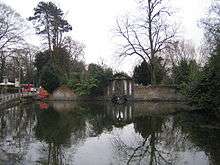
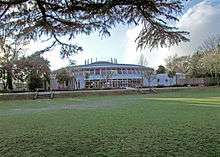
Ewell's largest landmark is Bourne Hall in the centre of the town. It is a modernist circular structure with a central glass dome, and is surrounded by a stream-side public park with a pond at one end and a fountain. The building, which is reminiscent of an immense flying saucer, houses a public library, subterranean theatre, gymnasium, café and local museum.
Bourne Hall regularly holds gatherings such as fairs, yoga and karate lessons. It was Grade II listed by English Heritage in 2015 for reasons of architectural interest: a striking design, notable for its space-age flair and the generous, top-lit principal interior space and plan form; the circular layout is well-organised, legible and flexible; and for historic interest: as an ambitious example of the expansion of the library service and the integration of community facilities and disabled access.
In the surrounding gardens are a garden wall and waterwheel[12] formerly belonging Garbrand Hall, the large mansion that Bourne Hall replaced.
Ewell has a C of E Parish Church (Saint Mary the Virgin, Ewell), which was designed by Henry Clutton and consecrated in 1848. The current building stands in a prominent position near the centre of the village on the old London Road. A replacement for an earlier church building on the site, it was built in a form of the Decorated Neo-Gothic style and faced with Swanage stone with Bath Stone mullions and tracery. The church is home to the 1889 'Father' Henry Willis pipe organ. The ruins of the old church's tower that was early medieval form a Scheduled Ancient Monument and stand alone in parkland.[13] St Paul's Howell Hill sits at the far east of the town and borough, and is known locally due to its prominent presence on a roundabout and its contemporary design.
Unlike most parts of its borough, Ewell has telephone numbers using the London 020 area code.[n 2] Ewell also has an unusually large telephone exchange, beside The Spring pub, fitted with underground facilities designed to survive a nuclear conflict during the later years of the Cold War. It was transferred in 2000 from the Metropolitan Police, in whose district it had been placed since 1839, to the jurisdiction of Surrey Police.
Neighbourhoods
Ewell Court
Ewell Court is a residential area and ward to the northwest of Ewell Village. In the centre of the area is Ewell Court Park, which contains Ewell Court House and Ewell Court Lake. The volunteer-run Ewell Court Library is inside Ewell Court House. A large portion of The Hogsmill Open Space, a local nature reserve is in this area, from the railway line near Ewell Village to Ruxley Lane. This contains several tributaries of the Hogsmill River, including the confluence with the Horton Stream near Ruxley Lane. Ewell Court is bounded to the northeast by the A240 (Kingston Road).
West Ewell
West Ewell is a large residential area with several local centres. Its main centre is the area around Ewell West railway station, which contains a parade of shops. Its largest roads are Chessington Road and Ruxley Lane. These are both B-roads which contain several parades of shops. A section of the Hogsmill Open Space, including the Bonesgate Stream is in the northern fringes of the area. Ruxley Farm Bridge is in the centre of Ruxley Lane over the Hogsmill River, replacing a ford, Ruxley Splash. West Ewell is served by buses travelling between Epsom and Kingston, as well as Chessington.
West Ewell covers two wards: West Ewell Ward, to the south of Ruxley Lane and Ruxley Ward, to the north.
Surrounding Area
Education

Closest to the town are at senior (secondary) level:
- private day school Ewell Castle School, on Church Street
- boys (Mixed in Sixth Form) Academy Glyn School, on The Kingsway[14]
- mixed comprehensive school Blenheim High School, Longmead Road
- mixed comprehensive school Epsom and Ewell High School on Ruxley Lane, West Ewell
At further education level:
For the wider list of all schools in the borough, see borough of Epsom and Ewell.
Sports, recreation and leisure
Ewell is also home to Ewell St. Mary's Morris Men. Founded in 1979, further to a bequest from the then Vicar, Peter Hogben, for the annual Village Fete – the Team danced into The Morris Ring in the late eighties and now have many unique dances in their repertoire. They dance Cotswold Morris and sport black top hats, red and white baldricks and ribbons.
The local sports club (Ebbisham Sports Club) cater for badminton, squash and tennis, in addition to having a social club.
In Ewell Court, there is a King George's Field in memorial to King George V. Also at the King George's Field, there is Ewell Athletics Track, a UK Athletics Class B track where Epsom and Ewell Harriers have trained since the 1950s. Epsom and Ewell Harriers were founded in 1890.[15] In 2000, The Harrier Centre was built. It is a small sports centre was built as an addition to the athletics track and also contains a children's soft play area.
Ewell Tennis Club[16] is in the town, catering for tennis players of all standards.
West Ewell Social Club is on Chessington Road.
Ewell is on the London Outer Orbital Path (London Loop) walking route. The path heads through South Cheam into Warren Farm and Nonsuch Park via East Ewell, before crossing into Ewell Village passing Ewell Castle School. It passes through Bourne Hall (at the main source of the Hogsmill River) before heading along the Hogsmill Open Space past the Kingston borough border.
Transport
Ewell is served by two railway stations: Ewell West, which has services towards London Waterloo, Dorking and Guildford, and Ewell East, which has services towards London Victoria, Dorking and Horsham. Both stations are in TfL Fare Zone 6.
Bus services in Ewell include the 293, 406, 418, 467, 470, E5 and E16 providing links to Morden, Kingston Upon Thames and Chessington.
Demography and housing
| Ward | Detached | Semi-detached | Terraced | Flats and apartments | Caravans/temporary/mobile homes/houseboats | Shared between households[1] |
|---|---|---|---|---|---|---|
| Cuddington | 627 | 782 | 435 | 520 | 0 | 2 |
| Ewell | 799 | 482 | 402 | 756 | 0 | 0 |
| Ewell Court | 666 | 1,200 | 127 | 225 | 2 | 0 |
| Nonsuch | 1,733 | 114 | 22 | 60 | 0 | 0 |
| Ruxley | 342 | 690 | 501 | 980 | 12 | 0 |
| West Ewell | 272 | 1,257 | 562 | 307 | 1 | 0 |
| Ward | Population | Households | % Owned outright | % Owned with a loan | hectares[1] |
|---|---|---|---|---|---|
| Cuddington | 5,934 | 2,366 | 39 | 43 | 135 |
| Ewell | 5,532 | 2,439 | 38 | 37 | 155 |
| Ewell Court | 5,417 | 2,220 | 49 | 40 | 146 |
| Nonsuch | 5,438 | 1,929 | 52 | 44 | 610 |
| Ruxley | 6,174 | 2,525 | 29 | 43 | 240 |
| West Ewell | 6,377 | 2,399 | 35 | 46 | 123 |
In art
Pre-Raphaelite artist William Holman Hunt married and produced several artistically and conceptually outstanding works here. The doorway linking St Mary's church yard and the grounds of Glyn House reproduced as the door on which Christ is knocking is arguably his most praised painting, The Light of the World.
Similarly, the background for John Everett Millais' oil on canvas Ophelia was painted at Ewell.
In film, fiction and the media
In August 2005 the borough of Epsom and Ewell was rated the most desirable place to live in the United Kingdom by the British television programme The Best and Worst Place to Live in the UK; the following year's edition figured it in 8th place. The borough's low crime rate, good education results and large number of open spaces were all cited as its particularly attractive features, although being less commercial than the centres of Kingston or London, having a relative 'lack of entertainment facilities'.
Other notable residents
Popular singer Petula Clark was born in Ewell in 1932, as well as the broadcaster James Whale, and TV presenter Michaela Strachan.
In sport, footballer Ron Harris[n 3] lived in Ewell during the 1970s, cyclist Sean Yates in childhood, Trevor "Tosh" Chamberlain [n 4] lives in the town, and Michael "Venom" Page was a former resident.[17] Michael Frayn, author and playwright, lived as a child in Hillside Road, off Queensmead Avenue, East Ewell.
Notes and references
- Notes
- It continues as since Roman times to Leatherhead and Dorking however terminates at the more modern resort of Worthing, 5 miles (8.0 km) east of the small port and cathedral city of Chichester on the coast.
- Anomaly shared with East Molesey and Thames Ditton in Surrey, Chigwell and Loughton in Essex
- Played for Chelsea Football Club
- Plays for Fulham Football Club
- References
- Key Statistics; Quick Statistics: Population Density United Kingdom Census 2011 Office for National Statistics Retrieved 20 December 2013
- "Archived copy". Archived from the original on 26 April 2014. Retrieved 26 April 2014.CS1 maint: archived copy as title (link)
- H.E. Malden, ed. (1911). "Parishes: Ewell". A History of the County of Surrey: Volume 3. Institute of Historical Research. Retrieved 5 July 2013.
- Walls, Tom K. "Prehistoric and Roman Settlement in Reigate Road, Ewell". Epsom & Ewell History & Archaeology Society. Retrieved 9 February 2015.
- B Matthews; R Bashford. "Glyn House, Ewell, Surrey: Phase 1 Evaluation Report". British and Irish archaeological bibliography. Oxford Archaeology. Retrieved 9 February 2015.
- Surrey Domesday Book Archived 30 October 2007 at the Wayback Machine
- Nonsuch Park House Historic England. "Details from listed building database (1378198)". National Heritage List for England. Retrieved 5 July 2013.
- Pepys' Diary Yowell References
- Ewell Castle Grade II Historic England. "Details from listed building database (1214625)". National Heritage List for England. Retrieved 5 July 2013.
- Ewell Court House Grade II Historic England. "Details from listed building database (1392614)". National Heritage List for England. Retrieved 5 July 2013.
- Richard Essen, The Archive Photographs Series: Epsom and Ewell (Stroud: The Chalford Press, 1994)
- The Waterwheel at Bourne Hall Grade II Historic England. "Details from listed building database (1232225)". National Heritage List for England. Retrieved 5 July 2013.
- Old Church Tower, Scheduled Ancient Monument Historic England. "Details from listed building database (1003721)". National Heritage List for England. Retrieved 5 July 2013.
- http://www.glyn.surrey.sch.uk
- http://www.eandeharriers.co.uk
- Ewell Tennis. "Ewell Tennis". Ewell Tennis. Retrieved 21 November 2010.
- "MICHAEL PAGE "VENOM"". badboy.com. Retrieved 13 April 2016.
